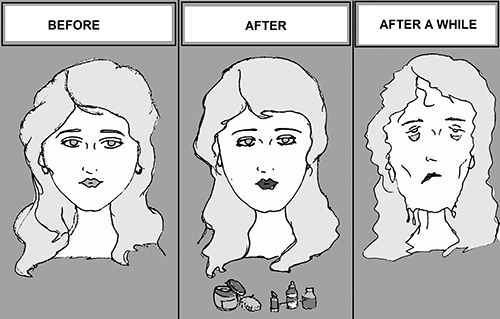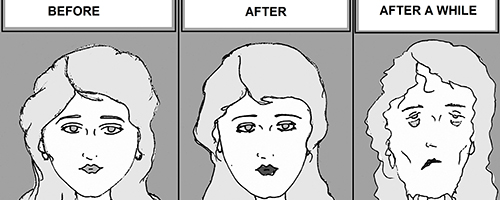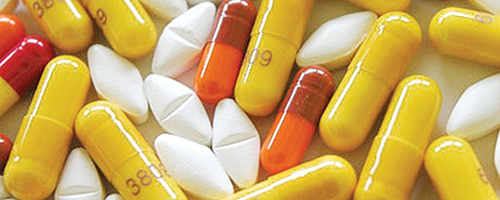There was a time when I hated wearing makeup. I didn’t enjoy the hassle of applying and then reapplying layers of foundation, bronzer, eyeliner and mascara. I still hate the idea of doing that over and over again, but last year I discovered eyebrow filler and, well, I’ve never been the same.
Kiss of death

There was a time when I hated wearing makeup. I didn’t enjoy the hassle of applying and then reapplying layers of foundation, bronzer, eyeliner and mascara. I still hate the idea of doing that over and over again, but last year I discovered eyebrow filler and, well, I’ve never been the same.
Since that fateful day, my love affair with makeup has blossomed into a committed relationship, complete with a morning ritual and me carrying a compact mirror in my purse at all times. A few months ago I got bored with my regular cat eye look and started wearing red lipstick a la Gwen Stefani.
Lipstick is a lot of fun. You can completely revolutionize or tone down an outfit with the right shade. However, the University of California, Berkeley, School of Public Health recently published a study in Environmental Health Perspectives that indicates the lipstick we’ve come to know and love might not be so good for us.
Most cosmetics available at the drugstore or makeup boutiques like Sephora are filled with all kinds of chemicals and man-made products. Many of us know this, but we’ve chosen to ignore the facts. Maybe we shouldn’t ignore them anymore.
The study stated that researchers tested “32 commonly sold lipsticks and lip glosses” and found that they contained “lead, cadmium, chromium, aluminum and five other metals.”
CBSnews.com reported that of the products tested in the study, half had levels of lead “in concentrations higher than [the] 0.1 parts per million cap the U.S. Food and Drug Administration places on candy frequently eaten by small children.”
Before you toss out all your lipsticks, though, consider the fact that these levels of contamination might not be too threatening. The long-term health risks depend on how much lipstick or gloss is absorbed. With the liberal amounts of gloss many lovely lipstick wearers here at Portland State use on a daily basis, this statistic is a little staggering.
Berkeley professor Katharine Hammond told the Huffington Post that this is just a starting point. She urged us not to panic, not to give up lipstick altogether, but said that the study’s results are disconcerting. “I don’t think this is trivial,” she said. “It needs to be addressed.”
Indeed it does. We’ve been using lipstick for decades.
Since the preliminary research results were released, the FDA has examined the levels of lead in lipsticks and concluded that the levels are too low to be considered a health risk. According to the Huffington Post, the FDA “has not set limits for lead in cosmetics.”
In fact, in the U.S. there isn’t a single standard set for the levels of metals in cosmetics, according to a press release issued by the study’s authors.
Linda Loretz, chief toxicologist for the Personal Care Products Council, didn’t think much of the study. She told the Huffington Post that these metals naturally exist in our environment, in our air, water and even food, concluding that it shouldn’t come as a surprise that trace levels were found in lipsticks.
So, even experts on both sides of the argument can’t definitively say whether lipstick is truly dangerous.
Products touting “all natural” labels are the answer, some might say. Then again, that these metals and other “toxic” substances occur in nature is the double-edged sword of mass-produced and readily available cosmetics. You’d be hard-pressed to find lipsticks at a higher-end store that didn’t also include the various substances the study warns us about.
Be that as it may, organizations like Skin Deep want consumers to know what’s in their cosmetics. Skin Deep provides a “safety profile of various cosmetics and body products,” and you should check it out before making your next makeup purchase.
No one has the time (or the means) to conduct their own safety tests on the makeup they wear. The products I use, which aren’t tested on animals, are probably filled with all kinds of substances that could be considered dangerous to my health.
Am I going to stop using them? No, probably not. Someday when I’m a wealthy English teacher (go ahead, laugh), I’ll be able to use the purest of red lipsticks and the most toxin-free eyebrow pencils. Until then, I’ll take these studies and articles with a grain of salt.
Makeup probably isn’t all that great for us anyway; I mean, it clogs up pores, it has a tendency to dry out skin and lips, it causes acne and who knows what else. But we enjoy wearing it. It provides us with a feeling of beauty, maybe even self-love. Until toxicologists prove that lipstick, eyeliner or any of their cosmetic cousins are actually detrimental to our health, I don’t think we have a whole lot to worry about.






